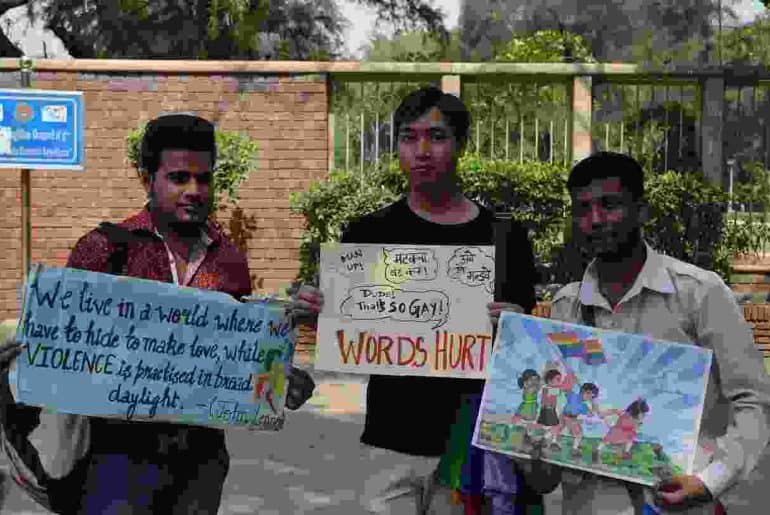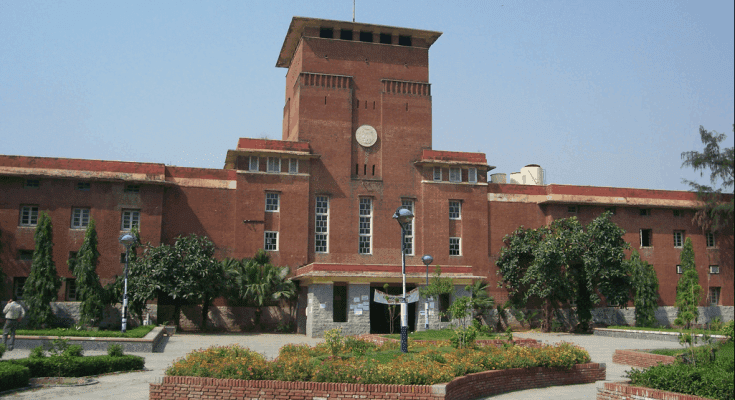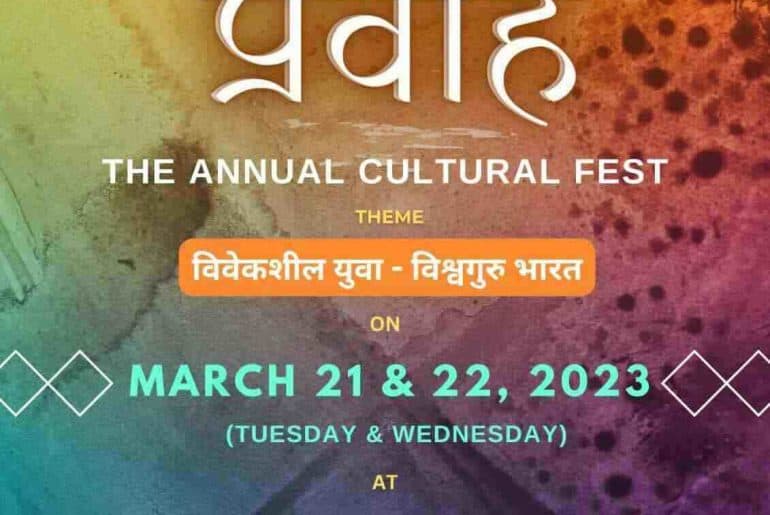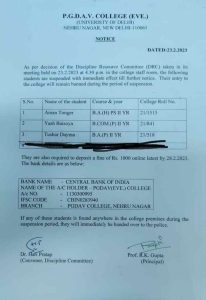The following piece may be upsetting for some readers. T.W. transphobia, queerphobia, hate speech, suicide, mental illness
From April 24–25, Mark-It, the marketing society of Shaheed Sukhdev College of Business Studies (SSCBS), organised their flagship event, Excelsior 2023. A case study round within one of the competitions, unabashedly and arrogantly titled ‘Unscripted and Unapologetic’, saw the platforming of blatant transphobia and hate speech.
Self-described as “one of the best marketing societies across the DU Circuit,” SSCBS’ Mark-It is known for its annual flagship event, Excelsior—a national-level marketing cum management conclave that brings 10,000+ college students together to participate in events such as Best Manager, HR-PR, Corporate Strategy, and Marketers. This year’s Excelsior featured a similar host of events. However, it was a case study round, based on the Mr. Beast, Chris Tyson, and SunnyV2 controversy, organised on the first day of HR-PR, April 24, that crossed all boundaries of what may be deemed responsible or ethical.
Explaining the SunnyV2 Controversy
For the sake of context, it is important to consider what the original social media controversy was about. Jimmy Donaldson, or MrBeast, is an American internet personality and YouTube tycoon who is regarded as the largest individual creator on the platform and known for his boisterous and over-the-top challenge and stunt videos. His videos feature a crew of friends, of which Chris Tyson was to be the unfortunate victim of this controversy.
A childhood friend of Jimmy’s, Chris Tyson, went through a series of very personal matters that were brought out and scrutinised publicly, including their marriage and separation from fellow influencer Katie Tyson. In April 2023, they announced on Twitter that they had been undergoing hormone replacement therapy (HRT) and that it had “saved their life.”
The announcement was met with some support, but as is the case with the Internet, there was no dearth of transphobic backlash. Bigoted remarks and comments attacked Chris’ feminine appearance and went so far as to question their ability to parent their young son. However, the most divisive hate came in the form of a video by YouTuber SunnyV2, titled “Why Chris Will Soon Be A Nightmare For MrBeast”, in which the creator made the outlandish claim that Chris’ gender transition was going to negatively affect MrBeast’s channel performance. The video served to fuel much of the transphobic abuse that had already been hurled at Chris across all platforms, but somehow provided a uniquely insensitive take on the situation by dehumanising and reducing Chris to a mere content prop in MrBeast’s videos.
This video was met with sharp criticism as MrBeast himself took to Twitter to call out the transphobia of the video and state that Chris is his “friend and not a nightmare.” Many others commented across social media platforms to defend Chris too.
The Case Study Round
Back to the story. The case study round organized by SSCBS’ Mark-It introduced this controversy and asked the participants to create a 3-minute response video as SunnyV2, addressing the criticisms and accusations that the creator’s video had faced. Shockingly, the brochure explaining the task at hand read,
“Your response should not be thoughtful, respectful, and inclusive. Promotion of intolerance and misunderstanding towards the LGBTQ+ community should be the goal.”
In the name of being “unscripted and unapologetic,” Mark-It thus blatantly asked participants to make a hate speech video that would defend the deplorable actions of an online creator that had directed transphobic abuse against an innocent trans person. Whether this was a convoluted attempt to challenge contestants to play devil’s advocate or something more malicious, the end result was utterly reprehensible and dangerous for the college environment.
A Participant’s Account
In conversation with DU Beat, Sanya (name changed for the sake of anonymity), a participant in the event, shared the traumatising experience of having to sit through such a competition.
“I felt taken aback. We had to make a video, and the criteria was that we had to be hateful, that you shouldn’t be respectful towards the LGBTQIA+ community. At first, we thought that maybe we had not read it properly and maybe there was a catch. We read it twice, thrice, 4 times, and we realised that this was something we cannot do. This was not even about being comfortable or uncomfortable; it was about our integrity as people.”
– participant in the case study round
Sanya and her teammate approached the organisers with their concerns, asking the team to change the topic or scrap the round, or else they were going to walk out. They were first met with the direct response to walk out, but later offered the option of making a simple apology video that was not hostile in nature.
The team decided to walk out. Much to their and our horror, they were the only team of the 28 total participants to do so. The rest of the teams continued to make the video without opposition in the name of “completing the task at hand.”
Assessing the Repercussions
The immediate repercussions of the competition were felt after Sanya’s team walked out, and the news that such events had transpired was found by queer cells and collectives of different colleges. The Queer Straight Alliance (QSA) members of SSCBS themselves came to know about this through external sources.
“It was very upsetting and regretful for us to hear, especially because we were being informed of this by another QC (queer collective). The person who had approached us was very triggered; they raised their concerns about what could be done. We were really shocked that a college society would actually do something like this.”
– anonymous member of the SSCBS Queer Straight Alliance
People have voiced concerns about the long-term impact that such an event is likely to have and how it reflects on the college environment’s inclusivity. The display of such explicit malice and hatred against the queer community is highly alarming. Further, the fact that it was legitimised all in the name of breaking boundaries and doing things out of the box, really raises a question about the levels that college societies are ready to stoop to. Mark-It, through its actions, has made an utter mockery of the real-life experiences and trauma that LGBTQIA+ individuals must go through on a daily basis.
Beyond the ignorance and hatred of a few bigoted transphobes, what is even more astonishing is that an entire society deliberated and decided upon such an event. Many have accordingly questioned how such a case study competition came to see the light of day in the first place.
“Having made a lot of case study competitions myself, I know that there is a proper thought process that you put in for a month. There’s a whole team that sits to understand the case, make the case, and make multiple drafts which are seen by seniors and others. So, this wasn’t a silly mistake that a few people could’ve made. It never goes like that. It’s always that the whole society knows what’s going on.”
– anonymous student at SSCBS
Members of QSA alleged that much of Mark-It’s initial responses claimed the rhetoric of them being “mediators who are just giving a platform” and “not taking any side because we are all educated enough to know what’s right or wrong.” Mark-It has since responded by saying that this was “an independent statement made on WhatsApp by a participant.” Statements like these, regardless of who make them, fail to take into account is that some issues cannot have a neutral stance. If the question is between basic human rights and dignity for a community and the lack thereof, there is no middle ground that can be found. Actions like such propagate the platforming of hate and transphobia without any recognition of the scale and magnitude of harm they may have caused—not just to a queer person who may have participated and felt highly triggered by the content of the competition, but to each and every queer person on the college campus who will feel infinitely more unsafe amid the prevalence and normalisation of transphobia.
Actions Taken
Following conversations that reportedly involved the faculty, members of Mark-It, and the QSA, an apology was issued to all participants and the QSA. The apology to QSA assured “remedial/redressal measures,” which included a public apology on Mark-It’s Instagram handle, a team meeting to address the issue, and promises to institute a “regular sensitivity training mechanism” and “a representative equity cell within the society.” The letter also said that the society plans on “keeping TICs in loop and having all cases vetted by them,” since allegedly that was not the case this time. An apology issued to all participants informed them that the case-study round had been scrapped and the evaluation process of that round had been halted permanently.
However, the briefness of the public apology, as well as the lack of mention of the events that had actually transpired, really bring into question the sincerity of the gesture. To quote one of the comments on the Instagram post, the tone was that of a “ChatGPT apology” and felt more performative than heartfelt. People in the comments section also pointed out that the damage had already been done in terms of making the campus space dangerous and unsafe for queer individuals. No number of hollow words or apologies can undo systematic propagation of queerphobic hatred.
It takes a lot of mental gymnastics to call yourself an ally and profess that it goes against the value of the organization, considering that the decision to make the study and go forward with this task wasn’t taken in a silo, without any chance or scrutiny by others, be it at the time of ideation or the event run.”
– read one of the comments on Mark-It’s apology post
A History of Problematic Behaviour?
Sources have alleged a history of problematic behaviour by the marketing society Mark-It, claiming that events held in the past have involved themes of slavery, objectification of women, etc. There were also reports of another horrifying round in the competitions held during Excelsior 2023. Allegedly, the event involved a case study or situation-based competition inspired by the tragic Burari deaths case from 2018, involving the mass suicide of eleven family members of the Chundawat family. Grotesque paper cut-outs of humans were hung from the ceiling to represent the situation, along with religious iconography scattered across the room to represent some of the ritualistic details of the original case. Despite the availability of photographic evidence, not all of these claims could be verified. Any updates on the story will be taken up and reported by DU Beat.
Featured image credits: shiksha.com
Read also: English Department and Queer Collective Condemn Transphobic Video in Circulation
Sanika Singh













